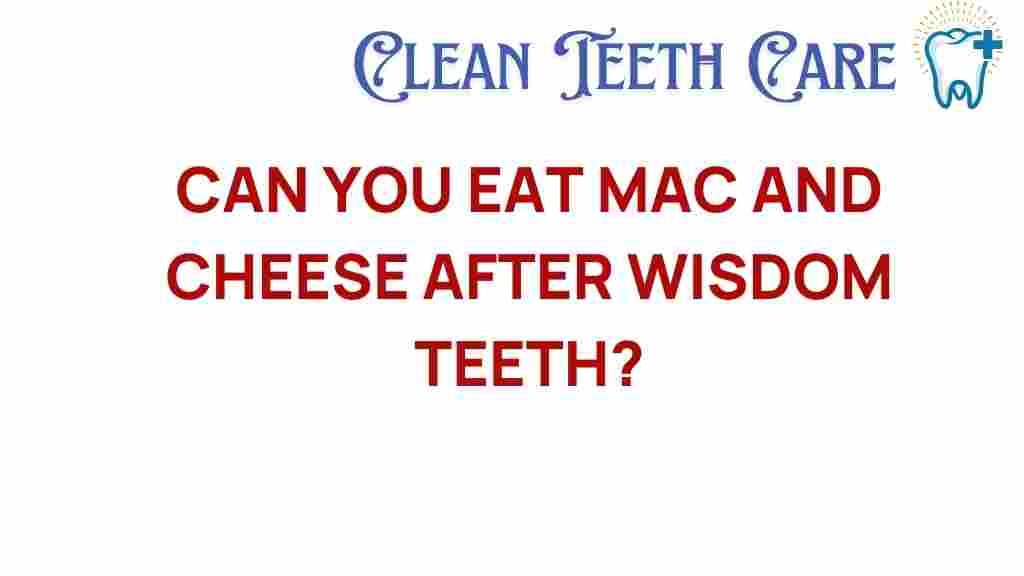Can You Really Eat Mac and Cheese After Wisdom Teeth Removal?
Undergoing wisdom teeth removal can be a daunting experience for many. After the dental surgery, the primary focus shifts to recovery and ensuring optimal oral health. One common question that arises during this period is, “Can you really eat mac and cheese after wisdom teeth removal?” In this article, we will explore the implications of consuming mac and cheese post-surgery, what to consider during recovery, and the importance of adhering to a soft food diet.
Understanding Wisdom Teeth Removal
Wisdom teeth, or third molars, often require removal due to various reasons, such as:
- Impaction
- Crowding of adjacent teeth
- Infection or gum disease
- Tooth decay
The procedure is typically performed under local or general anesthesia, and it may involve some degree of swelling and discomfort during the recovery phase. Proper post-operative care is essential for a smooth healing process.
The Importance of a Soft Food Diet
After wisdom teeth removal, your dentist or oral surgeon will likely recommend a diet consisting primarily of soft foods. This is crucial for several reasons:
- Minimizing Pain: Soft foods are easier to chew and swallow, reducing the strain on your healing gums.
- Preventing Complications: Hard or crunchy foods can irritate the surgical site, potentially leading to complications like dry socket.
- Promoting Healing: A diet rich in nutrients can aid in the recovery process.
Is Mac and Cheese a Safe Option?
Now, let’s address the main question: Can you eat mac and cheese after wisdom teeth removal? The answer is generally yes, but there are some considerations to keep in mind.
Benefits of Eating Mac and Cheese
Mac and cheese can be a comforting and satisfying meal during your recovery period for several reasons:
- Soft Texture: It is soft and easy to chew, making it an ideal choice for those recovering from dental surgery.
- High Caloric Content: It provides essential calories and carbohydrates that are beneficial when your appetite may be reduced.
- Customizable: You can modify it to include additional soft ingredients like pureed vegetables or proteins for added nutrition.
Considerations Before Indulging
While mac and cheese is generally safe, consider the following:
- Temperature: Ensure that the mac and cheese is not too hot, as this can irritate sensitive gums.
- Cheese Type: Opt for creamy cheese varieties that are easier to swallow. Avoid sharp or crumbly cheeses that may be harder to digest.
- Additions: Avoid adding crunchy toppings like breadcrumbs or bacon bits that could disrupt the healing process.
Step-by-Step Guide: Eating Mac and Cheese After Wisdom Teeth Removal
Here’s a simple guide to enjoy mac and cheese safely after your dental surgery:
- Wait for the Initial Recovery Period: For the first 24-48 hours, stick to liquids and very soft foods to allow your gums to start healing.
- Prepare Soft Mac and Cheese: Cook the pasta until it’s very soft and use a creamy sauce. You can even blend it slightly for a smoother texture.
- Check Temperature: Allow the dish to cool down to a lukewarm temperature before eating.
- Take Small Bites: Start with small spoonfuls to gauge your comfort level.
- Monitor Your Body’s Response: Pay attention to any discomfort or pain and stop eating if you experience any issues.
Other Soft Food Options to Consider
In addition to mac and cheese, here are some other soft food options that can be included in your diet:
- Mashed potatoes
- Yogurt
- Applesauce
- Smoothies
- Scrambled eggs
- Soups (without chunks)
Post-Operative Care Tips
To ensure a smooth recovery after your wisdom teeth removal, consider the following post-operative care tips:
- Follow Your Dentist’s Instructions: Adhere to the guidelines provided by your oral surgeon regarding diet and oral hygiene.
- Stay Hydrated: Drink plenty of fluids but avoid using straws, as sucking can dislodge clots forming in the extraction site.
- Manage Pain: Take prescribed pain medications as directed and apply ice packs to reduce swelling.
- Maintain Oral Hygiene: Gently rinse your mouth with warm salt water after 24 hours to keep the area clean.
Troubleshooting: What If You Experience Issues?
Sometimes, recovery does not go as planned. Here are some common issues and how to address them:
- Excessive Bleeding: If bleeding persists beyond 24 hours, contact your dentist immediately.
- Severe Pain: If pain worsens after the first few days, this could indicate an infection or dry socket; consult your dentist.
- Difficulty Eating: If you find it hard to eat even soft foods, consider pureeing your meals or switching to liquid diets temporarily.
Conclusion
In conclusion, eating mac and cheese after wisdom teeth removal can be a safe and enjoyable option as part of your recovery diet. Its soft texture, comforting nature, and versatility make it an excellent choice during this healing phase. However, always prioritize your comfort and follow your dentist’s recommendations for post-operative care. Remember, maintaining good oral health is crucial during recovery, and sticking to a soft food diet will help you heal effectively. For more information on oral health and recovery, visit this comprehensive guide or consult your dental professional.
With the right precautions and care, you can savor your mac and cheese while ensuring a smooth recovery process. Happy healing!
This article is in the category Treatments and created by CleanTeethCare Team
